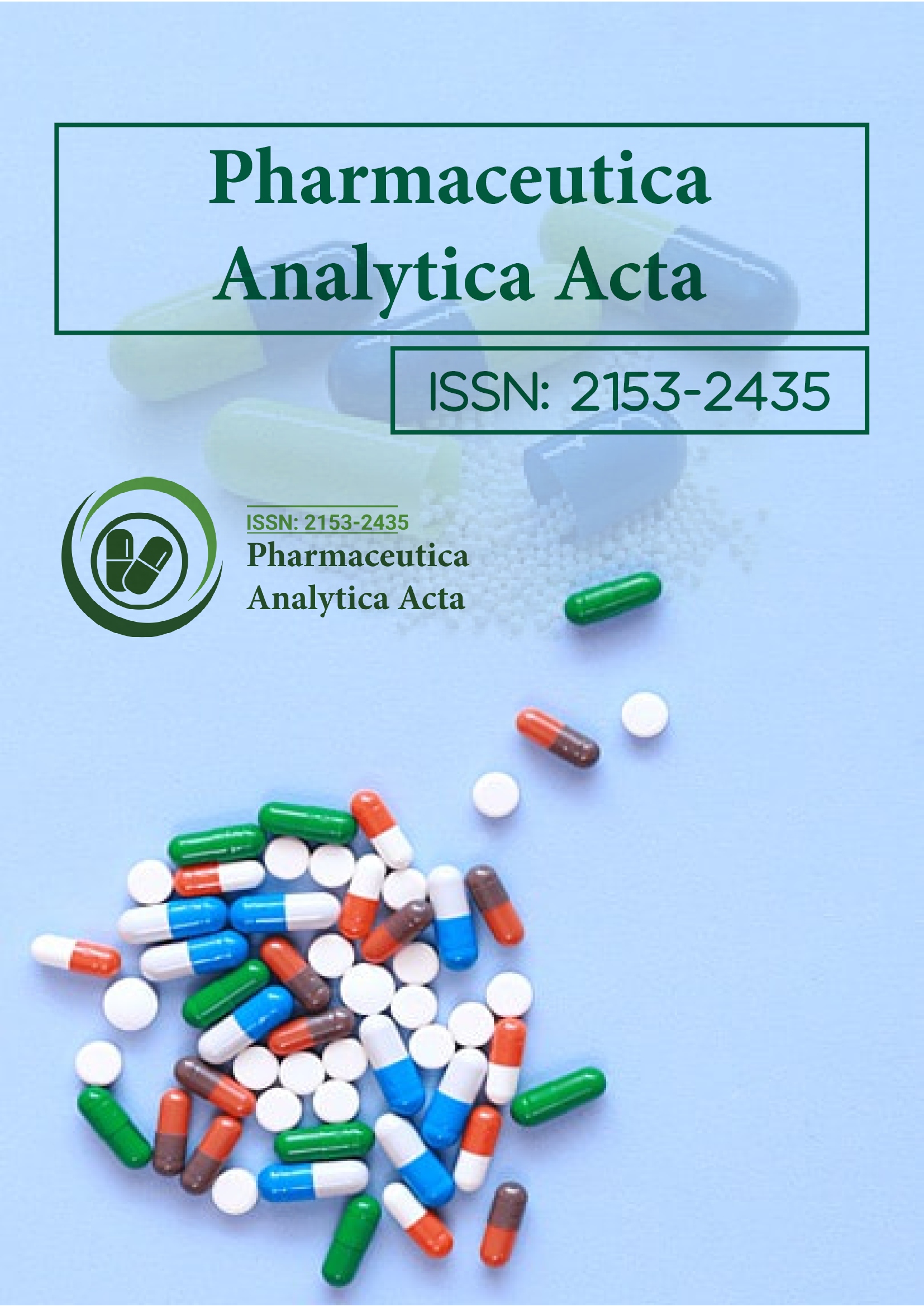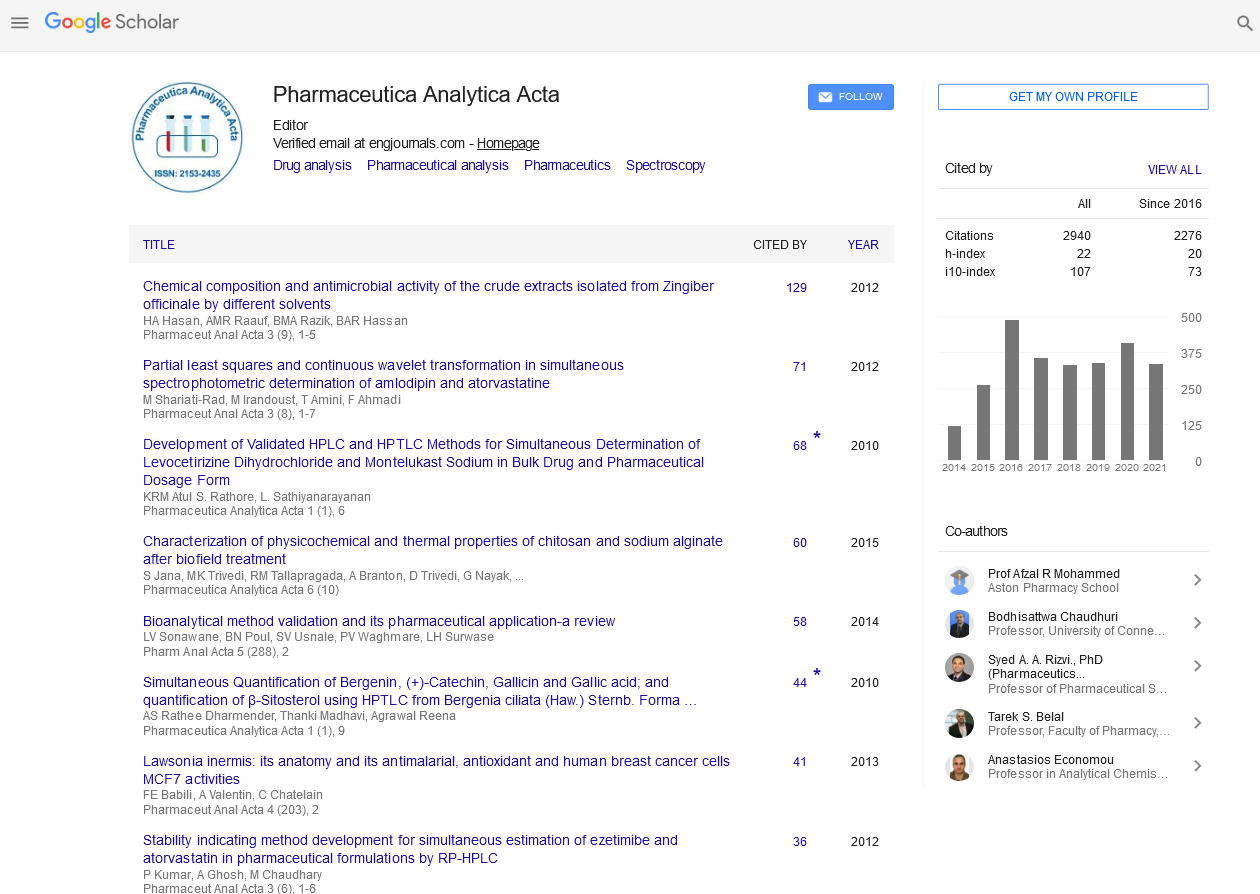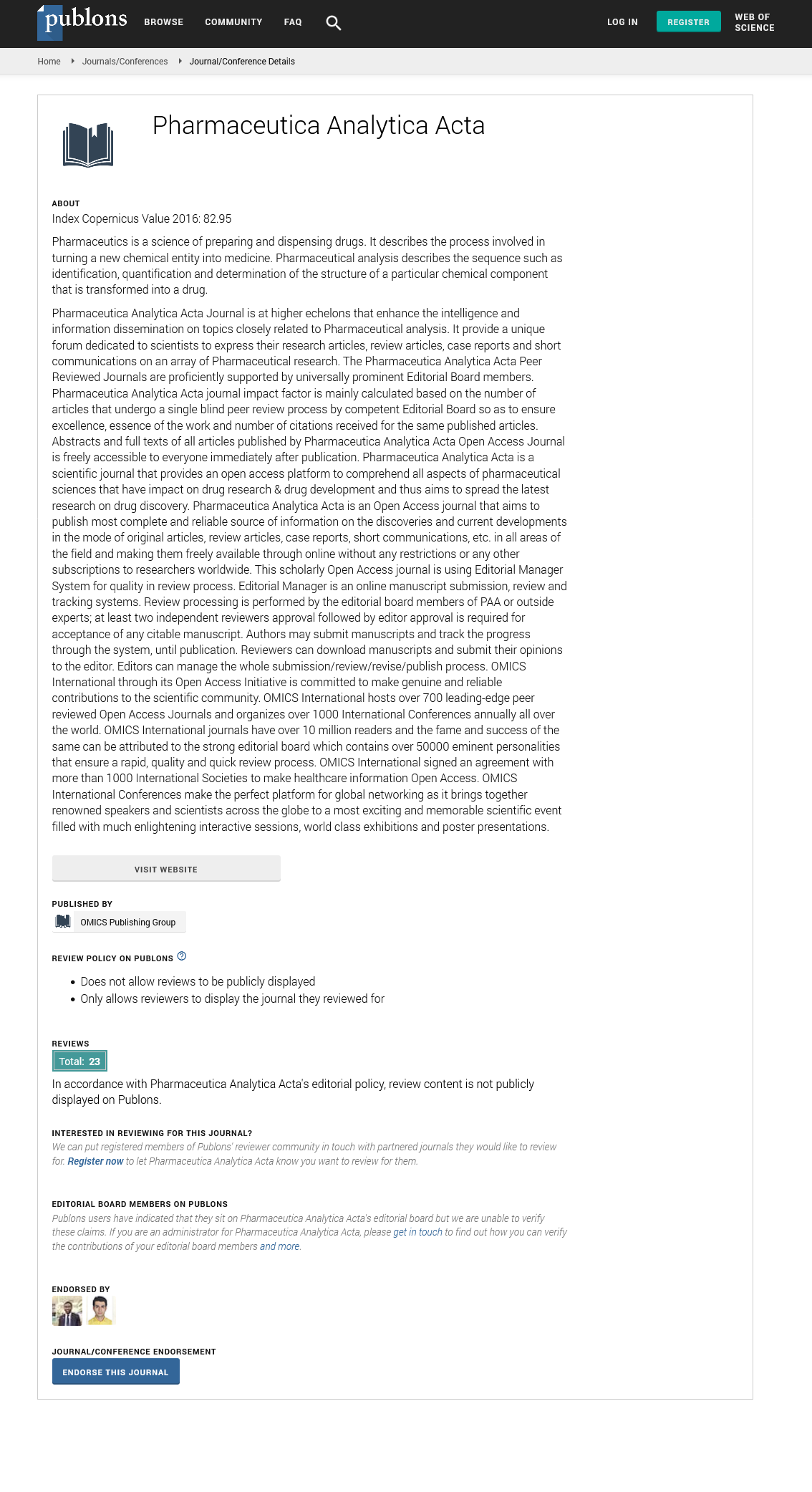Indexed In
- Open J Gate
- Genamics JournalSeek
- Academic Keys
- JournalTOCs
- The Global Impact Factor (GIF)
- China National Knowledge Infrastructure (CNKI)
- Ulrich's Periodicals Directory
- RefSeek
- Hamdard University
- EBSCO A-Z
- OCLC- WorldCat
- Publons
- Geneva Foundation for Medical Education and Research
- Euro Pub
- Google Scholar
Useful Links
Share This Page
Journal Flyer

Open Access Journals
- Agri and Aquaculture
- Biochemistry
- Bioinformatics & Systems Biology
- Business & Management
- Chemistry
- Clinical Sciences
- Engineering
- Food & Nutrition
- General Science
- Genetics & Molecular Biology
- Immunology & Microbiology
- Medical Sciences
- Neuroscience & Psychology
- Nursing & Health Care
- Pharmaceutical Sciences
Opinion Article - (2025) Volume 16, Issue 2
The Expanding Role of Spectroscopic Techniques in Pharmaceutical Analysis
Liang Zhang*Received: 31-May-2025, Manuscript No. PAA-25-30218; Editor assigned: 02-Jun-2025, Pre QC No. PAA-25-30218; Reviewed: 16-Jun-2025, QC No. PAA-25-30218; Revised: 21-Jun-2025, Manuscript No. PAA-25-30218; Published: 30-Jun-2025, DOI: 10.35248/2153-2435.25.16.816
Description
Spectroscopy has long been recognized as one of the most powerful tools in pharmaceutical analysis. Its ability to characterize molecular structure, confirm identity and evaluate purity makes it indispensable for both research and industrial applications. The modern pharmaceutical industry depends heavily on spectroscopic methods to ensure that every stage of drug development from synthesis to manufacturing and quality assurance is guided by precise and reliable information about the materials involved. Spectroscopy operates by examining how matter interacts with electromagnetic radiation, providing detailed insight into the atomic and molecular characteristics of substances. This interaction produces measurable spectra that can be interpreted to reveal structural and compositional information. Each spectroscopic method provides a different kind of data, allowing analysts to examine pharmaceutical compounds from multiple perspectives. When combined with other analytical techniques, spectroscopy becomes even more effective in identifying impurities, studying degradation pathways and confirming the authenticity of active ingredients.
One of the most commonly employed methods in the field is ultraviolet–visible spectroscopy. This technique measures the absorption of light across the ultraviolet and visible regions of the spectrum. Because molecular structures absorb light differently depending on the electronic transitions within their bonds, analysts can determine concentration and purity with high accuracy. It is particularly useful in quantifying active pharmaceutical ingredients and monitoring their stability during formulation and storage. The method is relatively simple, rapid and cost-effective, making it a routine tool in quality control laboratories around the world. Infrared spectroscopy provides another essential layer of information by identifying the vibrational frequencies of molecular bonds. Every functional group within a molecule such as carbonyl, hydroxyl, or amine groups exhibits unique absorption characteristics in the infrared region. This allows scientists to verify the presence or absence of specific chemical functionalities, detect impurities and evaluate whether a compound has undergone chemical modification. Infrared spectroscopy is also valuable for assessing interactions between drugs and excipients, offering clues about possible incompatibilities within a formulation.
For more detailed structural analysis, nuclear magnetic resonance spectroscopy is employed. This method reveals the arrangement of atoms within a molecule and helps confirm stereochemical configuration, which is particularly important for chiral compounds. The ability to determine how atoms are connected makes nuclear magnetic resonance spectroscopy indispensable in identifying unknown compounds and verifying synthetic outcomes. Pharmaceutical scientists rely on it to ensure that a drug substance possesses the correct molecular structure and that no unintended isomers or by-products are present. Mass spectrometry, another vital spectroscopic approach, provides molecular weight information and enables the identification of complex mixtures at trace levels. By ionizing molecules and measuring the mass of their charged fragments, analysts can deduce chemical composition with remarkable precision. This method is invaluable for detecting degradation products, metabolites, or contaminants that may occur during drug synthesis or storage. When combined with separation techniques such as chromatography, mass spectrometry allows for the simultaneous identification and quantification of multiple components in a formulation or biological sample.
Pharmaceutical formulations often contain not only active ingredients but also excipients, stabilizers and packaging-derived compounds that may complicate analysis. The ability of spectroscopic methods to discriminate between overlapping signals and identify subtle spectral differences is therefore crucial. Scientists develop calibration models and signal-processing strategies to minimize interference and extract accurate information from complex spectra. Advanced computational algorithms and chemometric methods further enhance the precision and interpretive power of spectroscopy, allowing analysts to resolve overlapping peaks and establish quantitative correlations between spectra and concentration. Another advantage of spectroscopy in pharmaceutical analysis is its non-destructive nature. Unlike techniques that consume or alter the sample, most spectroscopic methods can be performed without damaging the material being studied. This feature is particularly useful for in-line or on-line monitoring during manufacturing processes. Real-time spectral measurements can detect deviations in product composition or process parameters, allowing immediate corrective action and ensuring consistent product quality. Such applications have become an integral part of modern manufacturing strategies, enabling continuous monitoring of critical quality attributes without interrupting production.
Spectroscopy also contributes to regulatory compliance and intellectual property protection. When confirming the structural identity of generic drugs relative to their reference products, spectroscopic comparisons help demonstrate equivalence and ensure safety. Regulatory agencies around the world recognize the importance of validated spectroscopic methods in verifying authenticity, purity and stability. Analytical reports based on spectroscopic evidence often accompany drug submissions, supporting claims of quality and bioequivalence. Recent developments have further expanded the scope of spectroscopy in pharmaceutical science. Innovations such as Raman spectroscopy, near-infrared spectroscopy and terahertz spectroscopy are being adopted for rapid, non-invasive testing of raw materials and finished dosage forms. These emerging techniques provide deeper insights into solid-state properties, polymorphism and crystallinity factors that can affect dissolution rate, bioavailability and overall performance of a drug product. The portability of newer instruments also allows spectroscopic measurements to be performed outside traditional laboratories, including at manufacturing sites and even in clinical settings.
Citation: Zhang L (2025). The Expanding Role of Spectroscopic Techniques in Pharmaceutical Analysis. Pharm Anal Acta. 16:816.
Copyright: © 2025 Zhang L. This is an open-access article distributed under the terms of the Creative Commons Attribution License, which permits unrestricted use, distribution and reproduction in any medium, provided the original author and source are credited


